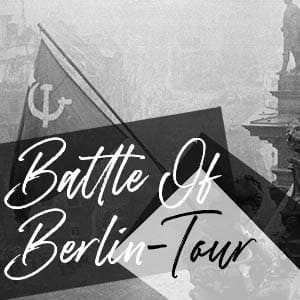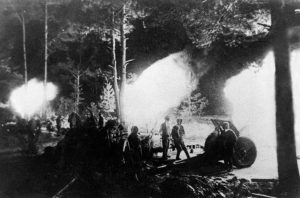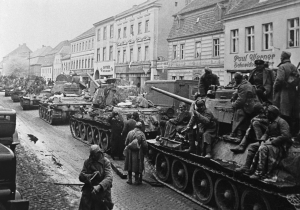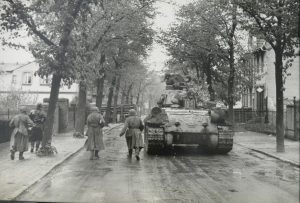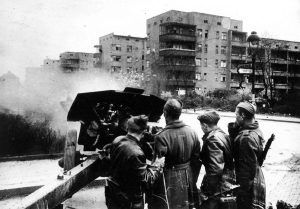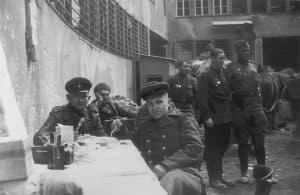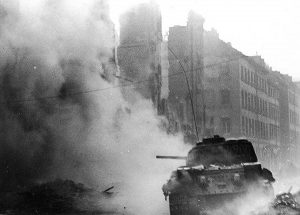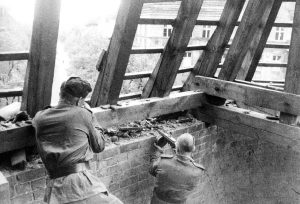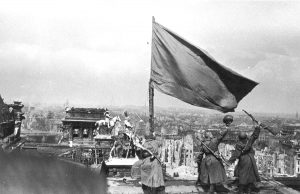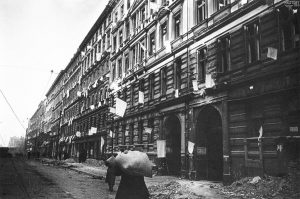Early on April 28th, Luftwaffe ace pilot Lieutenant-Colonel Hans Rudel flew to Berlin in a Heinkel 111, aiming to land on the East-West Axis in the Tiergarten and the improvised air strip that had been constructed there adjacent to the Reichstag building.
Targeted by Soviet anti-aircraft fire, Rudel was told landing would be impossible and never arrived in the city. He did, however, get a view of the devastation from above:
“It was very difficult to recognise the features of the city because of enormous clouds of smoke and a thin layer of mist. The fires were so fierce in some places that we were dazzled by them and prevented from seeing anything. I had to concentrate on the shadows in order to see anything and was unable to pick out the East-West Axis. There were flames and cannon-fire everywhere. The spectacle was fantastic.”
What he would not have managed to see from above was the toll the battle had taken on the local inhabitants and defenders. Bodies sat rotting under the debris of collapsed buildings. Women would still queue for water at outside pumps, scattering at the sound of artillery barrages or rifle fire, before coming together again in a neat line like Napoleonic infantry.
Improvised military field hospitals, that could be mistaken for slaughterhouses, had been set up in different buildings of defence district Zitadelle to treat the wounded – with soldiers taken to the Hotel Adlon, SS men delivered to the Reich Chancellery cellars, while the main city artery of Unter den Linden came to look like an open hospital in the later days of the battle.
A bloody wound stuffed with rubble and corpses.

Beneath the swirling smoke and mist of the city, would also be tens of thousands of Red Army casualties – more than 80,000 Soviet soldiers would die before the battle was over. With three mass graves eventually established in Berlin as war memorials after the war – one in Pankow, Treptower Park, and another less than a mile from the Reichstag building.
Others were simply buried where they fell.
The depleted ranks of the Soviet armies would come to be filled with recently liberated prisoners of war. Thirsty for revenge and often immediately pressed into service following their emancipation. The kind where they would be expected to fight to prove their allegiance.
The bloody advance into Defence Sector Z had come at a high cost to the Soviets – other battles though had been more costly, and the prize was nowhere near as great. The Battle of Stalingrad, for instance, that raged for nearly seven months costs the Red Army over 450,000 dead.
Although now, for the first time in four years of fighting against the fascist aggressor, the armed forces for the Soviet Union were within distance of the last objective of the war – the Reichstag building.
Lead elements of the 79th Rifle Corp advancing down the Alt Moabit street, in the afternoon, caught sight of the twisted remains of the building through the clouds of smoke and dust that obscured the centre of the city.
During the advance on the Reichstag, the leader of the 1st Guards Tank Brigade – Abraham Temnik – had been mortally wounded when his vehicle hit a mine. Born into a Jewish family in Ukraine, Temnik had joined the Red Army in 1929 and served in the battle of Khalkhin Gol in Mongolia, where Marshal Georgy Zhukov would make his name.
When as head of the 1st Belorussian Front, Marshal Zhukov, ordered the Commander of the 1st Guards Tank Army General Katukov to select a unit to enter Berlin, Katukov chose the 1st Guard Tank Brigade, which – with Temnik in charge – succeeded in breaching the defenses of the Nazi capital on April 21, 1945.
Abraham Temnik’s brigade was later entrusted with advancing into Berlin’s western district of Charlottenburg – and would be credited as being the first into the district, as the young boy from Ukraine stood in the hatch of the lead tank with a battle flag in his hands.
Whether this can be simply attributed to Soviet propaganda or not – Temnik would become one of the 402 Red Army soldiers awarded the status of Hero of the Soviet Union for exemplary actions and personal heroism during the Berlin operation. He would die from his wounds on April 29th – one day before the Soviet flag would be raised on the Reichstag.

The question of who would take the most important objective in Berlin was finally resolved on April 28th 1945 – when Stalin decided to redirect the men of the 1st Ukrainian Front under Ivan Konev’s command in the south of the city. Instead of moving on the Reichstag, his men would be sent to Savignyplatz in the west and tasked with clearing the remaining areas of the city beyond the Tiergarten. Konev would also be given a much greater order the same day; contacting Stalin to report on the progress of his Front, the Soviet leader would ask: “Who do you think is going to take Prague?” To which Konev suggested that his 1st Ukrainian Front would be able to move on the city from the west of Dresden.
At midnight Moscow time (10pm in Berlin), the Soviet military command issued new interfront boundaries based on a line which would run Mariendorf/Tempelhof Goods Station/Viktoria-Luise-Platz/Savignyplatz S-bahn Station.
Everything to the north would be designated as territory for the 1st Belorussian Front – and to the south reserved for Konev’ 1st Ukrainian Front.
The prize of taking the Reichstag building would be Georgy Zhukov’s alone – the task would fall to troops of the 3rd Shock Army in Zhukov’s 1st Belorussian Front to cross the heavily defended Moltkebrücke on April 29th.
The only means of crossing the River Spree to attack the Reichstag building – this massive stone bridge was barricaded at both ends, mined for demolition, and strewn with barbed wire and other obstacles. To the south of the bridge were the buildings of the diplomatic quarter and the Ministry of the Interior, followed by a series of trenches, gun emplacements, and mined areas. The windows in the Reichstag offered a commanding view of the area but had been bricked up save for small gunports – while artillery and mortar teams were located in the Tiergarten. A large water obstacle extending right across Königsplatz, the square in front of the parliament, would also heavily influence the line of Soviet attack.
Not only would the Red Army troops have to fight their way across the Möltkebrucke, they would also have to secure the heavily defended Diplomatic Quarter to establish a firm base for launching their main attack on the Reichstag.
Soviet estimates of opposition in the area were around 5,000 German troops – although the defenders were most likely fewer in number. With an unknown number of Allgemeine-SS defending the offices of the Interior Ministry, the route between the Möltkebrucke and the Brandenburg Gate lined with around 100 men, and a further 250 sailors from the Grossadmiral Dönitz Battalion and 100 Volkssturm in reserve. A number of tanks from the 11th SS Hermann von Salza Tank Battalion were also lurking in the Tiergarten.
Typical of the defence of the city at this time; lacking in men, material, and facing an overwhelming foe.

Earlier in the day, the final attempt to relieve Berlin was made by youth divisions attacking from the south-west of the city – part of General Wenck’s 20th Corps. These units – the Clausewitz, Scharnhorst, and Theodor Körner, were made up of men from officer training schools, and although they may have been some of the best troops held in reserve, they failed to succeed in pushing through the Soviet lines. Covering a distance of around 24km before being halted near Potsdam – some 32km from Berlin.
The Nazi capital was now doomed to its final dying throes.
For the German forces still fighting for their existence outside Berlin, there were other issues to contend with – as the Soviets continued their advance through the open country. The 3rd Panzer Army, led by General Hasso von Manteuffel, was marching away from Berlin in an attempt to halt the Soviet breakthrough at Neubrandenburg. As one of the two armies that made up Army Group Vistula, Manteuffel’s men were tasked with protecting the left flank of the capital from being overrun by the Soviet Marshal Rokossovsky’s 2nd Belorussian Front.
Driving through the countryside north of Berlin, on April 28th, Field Marshal Wilhelm Keitel – Commander-in-chief of the Wehrmacht noticed troops of the 7th Panzer Division and 25th Panzergrenadier Division moving north – contrary to orders from army command that Manteuffel’s troops should head to Berlin.
Heinrici had personally authorised the 3rd Panzer Army to retreat and was ordered to meet Keitel – dubbed by many of the men who served beneath him as ‘the gravedigger of the army’ – along with Manteuffel at a crossroads near Fürstenberg.
After receiving the full weight of Keitel’s rage, Heinrici was relieved of his command of Army Group Vistula.
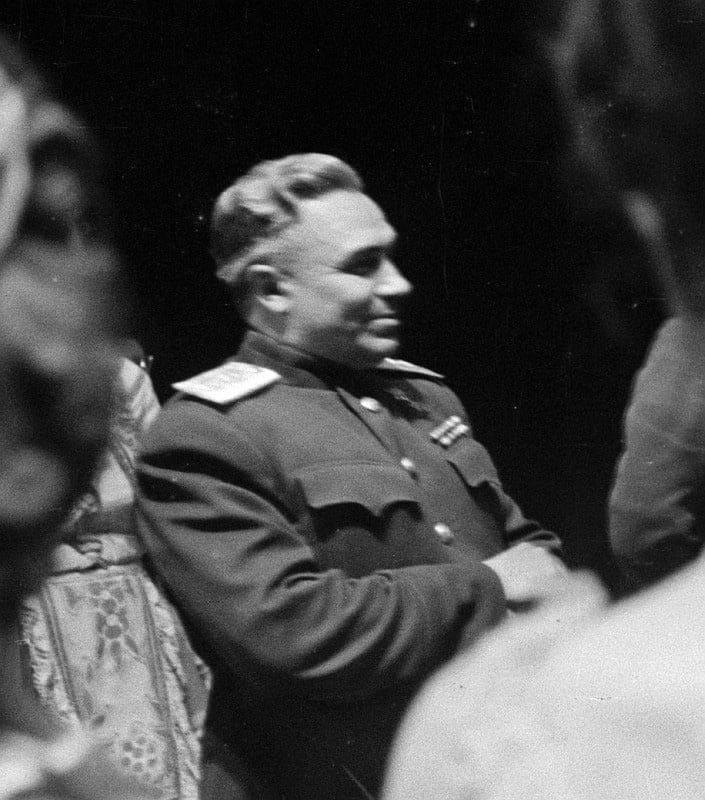
The same day, Red Army Colonel General Nikolai Berzarin assumed his role as the Chief of Garrison and City Commandant of Berlin, promptly issuing a curfew for German citizens and ordering the registration of all men of the armed forces, SS, SA, and police and firefighting services. Berzarin was commander of the 5th Shock Army, units of which had been the first to reach the outskirts of Berlin on April 21st. In an echo of the Tsarist tradition of rewarding the first commander to enter a city with command over it, Marshal Zhukov had appointed him commander of the city three days later.
Berzarin would work to re-establish order in the ruined German capital, creating a city police force and supplying the population with food, water, gas and electricity, as well as reopening schools and theatres.
While the battle of Berlin still raged, the Soviets were already preparing the ground for their total conquest of the city.

Meanwhile, the embattled SS Müncheberg Division, having fought through the district of Wilmersdorf, had pulled back towards the centre of the city by April 28th. Second Lieutenant Krömer described the situation:
“Potsdamer Platz is a ruined waste. Masses of wrecked vehicles and shot-up ambulances with the wounded still inside them. Dead everywhere, many of them frightfully mangled by tanks and trucks. In the evening we try to get news from the Propaganda Ministry of Wenck and the American divisions. There are rumours that the 9th Army is also on its way to Berlin and that peace treaties are being signed in the west. Violent shelling of the city centre at dusk with simultaneous attacks on our position. We cannot hold onto Potsdamer Platz any longer…”
Soviet General Berzarin’s 5th Shock Army had made substantial progress on April 28th along the broad expanse of Leipzigerstrasse and were now less than 1,500 yards from the Reich Chancellery.
Where in the Führerbunker beneath the Chancellery gardens on the evening of April 28th more unwelcome news would reach the Nazi leader.
At around 9pm word of SS chief Heinrich Himmler’s negotiations with Count Bernadotte of Sweden were intercepted by the Propaganda Ministry from a Reuters broadcast in German on Radio Stockholm and relayed to Hitler. As Vice President of the Red Cross, Bernadotte had been secretly negotiating with the SS leader for the release of concentration camp prisoners – bargaining chips for Himmler who had his sights on a greater prize, a meeting with US commander Dwight Eisenhower and the possibility of German surrender on the western front while prolonging the battle in the east.
Hitler was furious at Himmler’s treachery and ordered his immediate arrest.
Betrayal by Der Treue Heinrich (The loyal Heinrich) only further exacerbated the Nazi leader’s suspicion of those around him and his faith in the allegiance of the most trusted members of his inner circle.
Hermann Fegelein, Himmler’s assistant, remained in Gestapo custody and was interrogated by secret police chief Heinrich Müller – confessing that he had known about Himmler’s approaches to Count Bernadotte. He was taken away by an SS escort and shot. Not even his marriage to Gretl Braun – whose sister, Eva, Hitler would soon marry – could save him.
That night, Hitler announced his intention of marrying his long term mistress and Joseph Goebbels – who had repeatedly professed his fanatical dedication to loyally remain by the Führer’s side until the end – was tasked with procuring an official to perform the ceremony.
Soon a nervous and overawed figure emerged, wearing his brown Nazi party uniform and Volkssturm armband – by the name of Wagner.
A fitting irony in one of the final episodes in Hitler’s Götterdammerung.
**
Our Related Tours
Want to learn more about the Battle of Berlin? Check out our Battle of Berlin tours to explore what remains of this important urban battlefield.
To learn more about the history of Nazi Germany and life in Hitler’s Third Reich, have a look at our Capital Of Tyranny tours.
Bibliography
Beevor, Antony (2003) Berlin: The Downfall 1945 | ISBN 978-0-14-028696-0
Hamilton, Aaron Stephan (2020) Bloody Streets: The Soviet Assault On Berlin | ISBN-13 : 978-1912866137
Kershaw, Ian (2001) Hitler, 1936–1945: Nemesis | ISBN 0-393-04994-9
Le Tissier, Tony (2010) Race for the Reichstag: the 1945 Battle for Berlin | ISBN: 978-1848842304
Le Tissier, Tony(2019) SS Charlemagne: The 33rd Waffen-Grenadier Division of the SS | ISBN: 978-1526756640
Mayo, Jonathan (2016) Hitler’s Last Day: Minute by Minute | ISBN: 978-1780722337
McCormack, David (2017) The Berlin 1945 Battlefield Guide Part I the Battle of the Oder-Neisse | ISBN: 978-1781556078
McCormack, David (2019) The Berlin 1945 Battlefield Guide Part II The Battle of Berlin | ISBN: 978-1781557396
Moorhouse, Roger (2010) Berlin at War | ISBN: 978-0465028559
Ryan, Cornelius (1966) The Last Battle | ISBN 978-0-671-40640-0
Sandner, Harald (2019) Hitler – Das Itinerar, Band IV (Taschenbuch): Aufenthaltsorte und Reisen von 1889 bis 1945 – Band IV: 1940 bis 1945 | ISBN: 978-3957231581
Shirer, William L. The Rise and Fall of the Third Reich | ISBN 978-1451651683.

